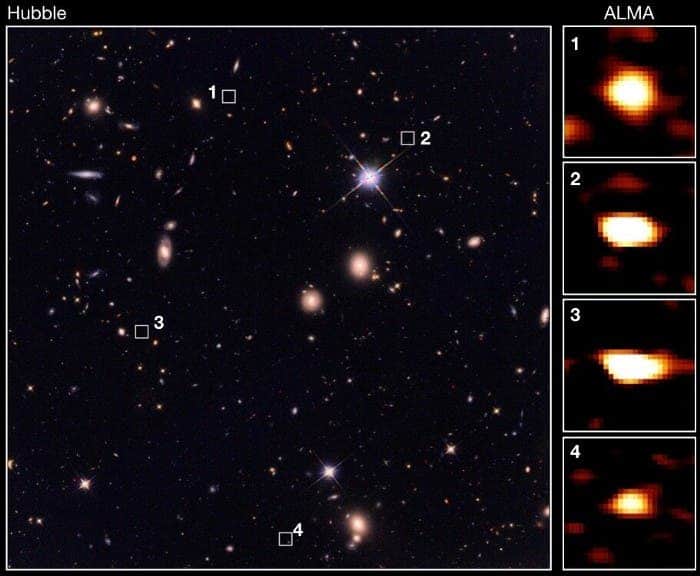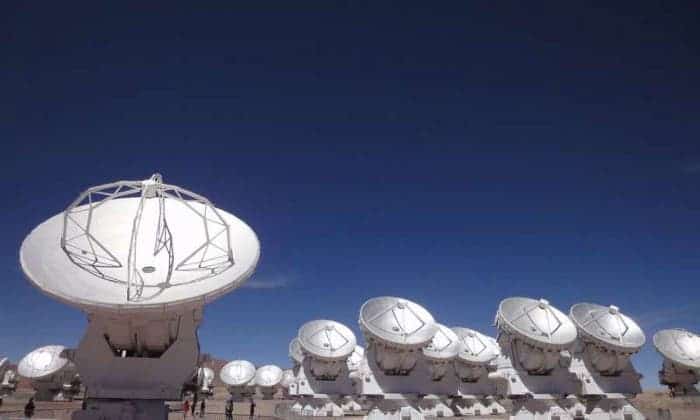The discovery of 39 ‘hidden’ ancient galaxies urges scientists to rethink their theories of fundamental aspects of the Universe — including supermassive black holes, star formation rates, and the ever-elusive, dark matter.

In an unprecedented discovery of astronomers, researchers have utilised the combined power of a multitude of observatories across the globe to discover a vast array of 39 previously hidden galaxies.
The finding — described by the researchers from the University of Tokyo as a ‘treasure trove’ — is the first multiple discoveries of this kind. But the finding is significant for more than its size alone.
In addition to containing a wealth of newly discovered ancient galaxies, an abundance of this particular type of galaxy suggests that scientists may have to refine current models of the universe.
This is because our current understanding of the universe and how it formed is built upon observations of galaxies in ultraviolet light. But observations in these wavelengths under-represent the most massive galaxies — those with high dust content and crucially, the most ancient.
This means that a discovery of such galaxies — such as the one just made — must force us to reconsider the rates of star formation in the early universe. The study explains that the population of stars discovered may mean that star formation rates were actually ten times greater in early epochs than previous estimates held.
There are also particular ramifications for our understanding of both supermassive black holes and their distribution, and for the concept of dark matter — the elusive substance which makes up 80% of the matter in the universe.
Despite the wealth of astronomical data that has become available to scientists since the launch of the Hubble Space Telescope, researchers at the Institute of Astronomy in Toyko were aware there were things that Hubble simply couldn’t show us. It was these things — fundamental pieces of the cosmic puzzle — that they wanted to investigate.
They achieved this by unifying different observatories, using them to look more deeply in the Universe than Hubble alone could do. This is what led them to this huge collection of galaxies.
Researcher Tao Wang describes the uniqueness and magnitude of the team’s discovery: “This is the first time that such a large population of massive galaxies was confirmed during the first two billion years of the 13.7-billion-year life of the universe.
“These were previously invisible to us.”
Wang continues: “This finding contravenes current models for that period of cosmic evolution and will help to add some details, which have been missing until now.”
A different view of the universe
Wang explains that if we could see these galaxies and the light they shed, our view from the Milky way would be significantly different: “For one thing, the night sky would appear far more majestic. The greater density of stars means there would be many more stars close by appearing larger and brighter.
“But conversely, the large amount of dust means farther-away stars would be far less visible, so the background to these bright close stars might be a vast dark void.”
The galaxies have been difficult to see from Earth due to how faint they are. Were we able to see these stars, their density would make the night sky majestic, Wang says.
The light from these galaxies also has to battle extinction — the absorption of light) by intervening interstellar dust clouds. The light from the galaxies also has to travel great distances meaning the wavelength is redshifted by the expansion of the universe making it even less visible.

Professor Kotaro Kohno explains that this phenomenon is how the galaxies escaped Hubble’s gaze: “The light from these galaxies is very faint with long wavelengths invisible to our eyes and undetectable by Hubble.
“So we turned to the Atacama Large Millimeter/submillimeter Array (ALMA), which is ideal for viewing these kinds of things. I have a long history with that facility and so knew it would deliver good results.”
This redshift due to cosmic expansion does have its advantages, however. It allows astronomers to estimate not just the distances to the galaxies in question, but it also allows them to calculate just how long ago the light was emitted.
The hidden implications of these hidden galaxies
The team’s finding is so controversial and poses such a radical rethink that they found their fellow astronomers were initially reluctant to believe they had found what they claimed.

Wang explains: “It was tough to convince our peers these galaxies were as old as we suspected them to be. Our initial suspicions about their existence came from the Spitzer Space Telescope’s infrared data.
“But ALMA has sharp eyes and revealed details at submillimeter wavelengths, the best wavelength to peer through dust present in the early universe. Even so, it took further data from the imaginatively named Very Large Telescope in Chile to really prove we were seeing ancient massive galaxies where none had been seen before.”
The discovery has the potential to reshape our ideas of the supermassive black holes that scientists currently believe nestle at the centre of most galaxies.
Kohno elaborates: “The more massive a galaxy, the more massive the supermassive black hole at its heart.
“So the study of these galaxies and their evolution will tell us more about the evolution of supermassive black holes, too.”
Kohno also explains that some ideas regarding dark matter may have to be revised, too: “Massive galaxies are also intimately connected with the distribution of invisible dark matter. This plays a role in shaping the structure and distribution of galaxies. Theoretical researchers will need to update their theories now.”
In addition to the potential shake up the team believes that their findings may already present, they expect more surprises to come.
Wang concludes: These gargantuan galaxies are invisible in optical wavelengths so it’s extremely hard to do spectroscopy, a way to investigate stellar populations and chemical composition of galaxies. ALMA is not good at this and we need something more.
“I’m eager for upcoming observatories like the space-based James Webb Space Telescope to show us what these primordial beasts are really made of.”
Original research: T. Wang, C. Schreiber, D. Elbaz, Y. Yoshimura, K. Kohno, X. Shu, Y. Yamaguchi, M. Pannella, M. Franco, J. Huang, C.F. Lim & W.H. Wang. A dominant population of optically invisible massive galaxies in the early Universe. Nature. DOI: 10.1038/s41586–019–1452–4


